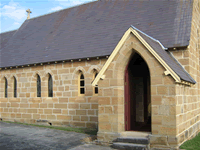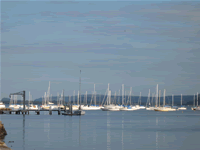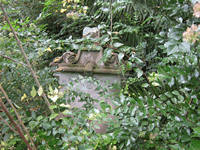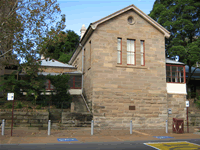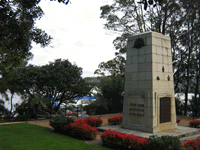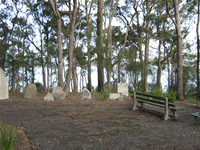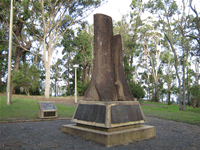|
|
The city of Gosford is located at the North West shore of Brisbane Water and is the seat of administration for the Gosford Shire Council. From its pioneer beginnings Gosford as grown into a major metropolis within its own right, with an abundance of local industry. Initially the area of Gosford and its surrounds key industry was timber getting and the collection of shells for lime. Modern day Gosford initially began as two seperate townships. A private township located at what is now East Gosford was founded by Samual Peak in 1822. The Government township of Gosford, named after the Earl Of Gosford Archibold Acheson, was not surveyed and established until some years later in 1839, in the area around Point Frederick. Initally the private township was the more prosperous of the two, however the land sold slowly to absentee landowners and services were limited to a few hotels, a store and a wharf and by the early 1840's the financial burden had become too great for Peak, who lost his controlling interest in the township during the depression. The growth of the young region presented the need for law and order and so the original Gosford Watch-house was built in 1827 to service the local community, which numbered over 100 by this time. Around 1833 the the first Gosford Courthouse was built adjacent to the watch-house, which was rapidly proving to be inadequate. In 1849 a replacement courthouse and police station was built, complete with two cells, constables room and a yard. It underwent several additions in 1892 and 1928 and remained in use until 1983. A plaque on the front of the old courthouse salutes the efforts of Gother Kerr Mann who served as local magistrate 1839-1849. He later became chief commissioner for the infant railway system. The first church in Gosford is recorded to be Greenoaks Rectory at 1 Mann St Gosford. The first rectory was completed in 1843 and constructed of local sandstone and cedar. The original rectory was replaced in 1913 and the old rectory demolished. Christ Church still stands to this day, built originally in 1858 in the private township, it was moved brick by brick to its current location in Gosford in 1905. Carefull examination of the outside of the church can still reveal traces of the numbering system used during its relocation. The private and government townships began to merge during the 1850's and were eventually declared a municipality in the 1880's. Land use of the area was slowling changing and the population and number of buildings continued to grow. Timber getting had peaked by 1830 and shipbuilding was one of the main industries of Brisbane Water and continued up until the mid 1950's. By the 1880's agriculture began to take hold and land in Gosford was by then selling for around 6 pounds per acre, uncleared. A great deal of land was subdivided into smaller blocks at this time and sold off for farming, most notable of these subdivisions was Gosford Model Farms, a venture by auctioneers Boyd and King of Sydney. Citrus orchards were planted where timbergetters had already cleared the land and these orchards soon extended to the Somersby Plateau and by 1934 produced over a third of the states citrus crop. Market gardens and passionfruit also began appearing in the district but until the completion of the railway in 1889 transportation of produce was limited to water routes limiting the speed and volume of delievery to Sydney, its main market. With the opening of the railway Gosford also benefitted from the large number of tourists eager to escape the hustle and bustle of city life and many visited the area to enjoy hunting, fishing and sight seeing. Guest houses and hotels were constructed to provide overnight accommodation and Gosfords tourist industry was born. In 1930 the Pacific Highway was completed, replacing the more circuitous route via Wisemans Ferry previously used and encouraging short stay visitors.
In the 1940's and 1950's Gosford began to urbanise and the expansion of metropolitan Sydney coupled with affordable land prices contributed to the rapid increase in residential growth. No more a rural community, Gosford has grown to be a city in its own right (proclaimed a city in 1980) and although agriculture and horticulture persist in the mountainous area's surounding Gosford they are declining rapidly in importance to employment and production. Tourism still continues to be an important industry for Gosford and surrounds. The merging of pioneer history and modern lifestyle give Gosford a dual appeal and the proximity of the beautifull Brisbane Water with its large expanse of open water providing sport, fishing and boating oportunities, all such a short drive from Sydney make Gosford an ideal weekend getaway or holiday destination. The Pioneer Cemetery at point Frederick is a beautifully shady spot that includes a monument to the timbergetters that first settled in the Gosford area. Set out amongst the landscaped lawns and pathways are gravestones of early settlers of the area. Historical Manns Street Walk. Starting at the beginning of Manns Street from the Memorial Park and finishing at the Donnison Street and Mann Street intersection is a fantastic historic walk through Gosford where a number of historic buildings and sites are to be found. Most of the more interesting buildings carry a plaque describing its significance or history. Gosford CBD is a thriving shopping centre and business district. Many opportunities are to be found here from an all out shopping spree to a relaxing coffee in one of Gosfords cafes. Gosford Visitor Information Centre is located at 200 Mann Street.
© 2008 Centralcoast.info |
